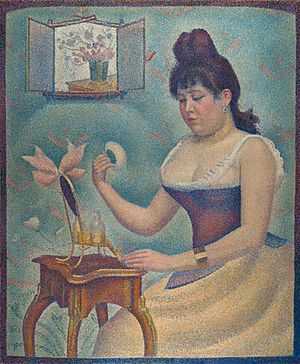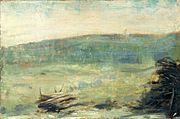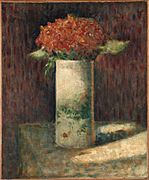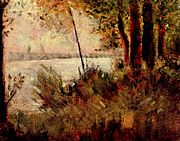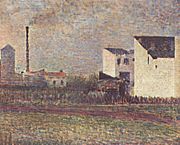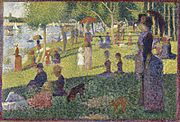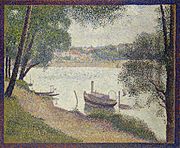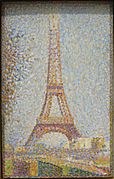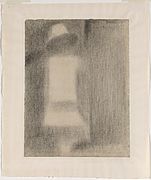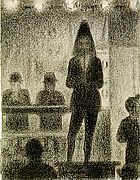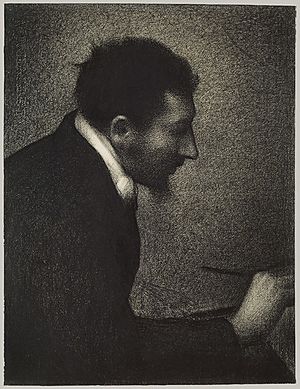Georges Seurat facts for kids
Quick facts for kids
Georges Seurat
|
|
|---|---|
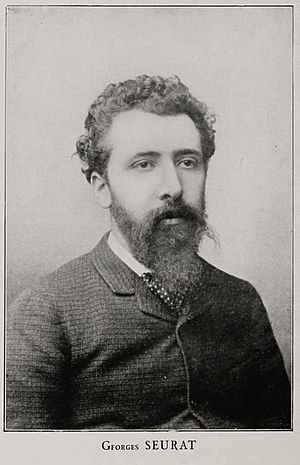
Seurat in 1888
|
|
| Born |
Georges-Pierre Seurat
2 December 1859 Paris, France
|
| Died | 29 March 1891 (aged 31) Paris, France
|
| Nationality | French |
| Known for | Painting |
|
Notable work
|
A Sunday Afternoon on the Island of La Grande Jatte Bathers at Asnières List of paintings |
| Movement | Post-Impressionism, Neo-Impressionism, Pointillism |
| Partner(s) | Madeleine Knobloch |
Georges Pierre Seurat ( sur-AH-,_---ə SUU-rah 2 December 1859 – 29 March 1891) was a French post-Impressionist artist. His scientific ideas about colour then led him to develop a different painting technique. He painted in tiny dots of colour, with the theory that the viewer's eye would mix them. This technique is called "pointillism". He also used conté crayon for drawings on paper with a rough surface.
His large-scale work A Sunday Afternoon on the Island of La Grande Jatte (1884–1886) altered the direction of modern art by initiating Neo-Impressionism, and is one of the icons of late 19th-century painting.
Contents
Biography
Family and education
Seurat was born on 2 December 1859 in Paris, at 60 rue de Bondy (now rue René Boulanger). His father, Antoine Chrysostome Seurat, originally from Champagne, was a former legal official who had become wealthy from speculating in property. His mother, Ernestine Faivre, was from Paris. Georges had a brother, Émile Augustin, and a sister, Marie-Berthe, both older. His father lived in Le Raincy and visited his wife and children once a week at boulevard de Magenta.
Georges Seurat first studied art at the École Municipale de Sculpture et Dessin, near his family's home in the boulevard Magenta, which was run by the sculptor Justin Lequien. In 1878, he moved on to the École des Beaux-Arts where he was taught by Henri Lehmann. As part of his academic training, he drew from casts of antique sculpture and copied drawings by old masters. His formal artistic education came to an end in November 1879, when he left the École des Beaux-Arts for a year of military service.
After a year at the Brest Military Academy, he returned to Paris where he shared a studio with his friend Aman-Jean. For the next two years, he worked at mastering the art of monochrome drawing. His first exhibited work, shown at the Salon, of 1883, was a Conté crayon drawing of Aman-Jean.
Bathers at Asnières
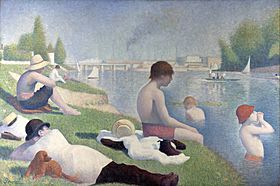
He spent 1883 working on his first major painting – a large canvas titled Bathers at Asnières, a monumental work showing young men relaxing by the Seine in a working-class suburb of Paris.
Bathers at Asnières was rejected by the Paris Salon, and instead he showed it at the Groupe des Artistes Indépendants in May 1884. Soon, Seurat and some other artists – including Charles Angrand, Henri-Edmond Cross, Albert Dubois-Pillet and Paul Signac – set up a new organization, the Société des Artistes Indépendants. Seurat's new ideas on pointillism were to have an especially strong influence on Signac, who subsequently adpoted this technique.
A Sunday Afternoon on the Island of La Grande Jatte

In summer 1884, Seurat began work on A Sunday Afternoon on the Island of La Grande Jatte.
The painting shows members of each of the social classes participating in various park activities. It took Seurat two years to complete this 10-foot-wide (3.0 m) painting, much of which he spent in the park sketching in preparation for the work. There are about 60 studies for the large painting, including a smaller version, Study for A Sunday Afternoon on the Island of La Grande Jatte (1884–1885), which is now in the collection of The Art Institute of Chicago. The full work is also part of the permanent collection of the Art Institute of Chicago.
The painting was the inspiration for James Lapine and Stephen Sondheim's musical Sunday in the Park with George and played a significant symbolic role in John Hughes' Ferris Bueller's Day Off.
Later career and personal life
Seurat was in a relationship with Madeleine Knobloch (or Madeleine Knoblock, 1868–1903), an artist's model whom he portrayed in his painting Jeune femme se poudrant. She gave birth to their son, who was named Pierre-Georges, on 16 February 1890.
Seurat spent the summer of 1890 on the coast at Gravelines, where he painted four canvases including The Channel of Gravelines, Petit Fort Philippe, as well as eight oil panels, and made a few drawings.
Death
Seurat died in Paris in his parents' home on 29 March 1891 at the age of 31. The cause of his death is uncertain, and has been variously attributed to a form of meningitis, pneumonia, infectious angina, and diphtheria. His son died two weeks later from the same disease. His last ambitious work, The Circus, was left unfinished at the time of his death.
On 30 March 1891 a commemorative service was held in the church of Saint-Vincent-de-Paul. Seurat was interred 31 March 1891 at Cimetière du Père-Lachaise.
At the time of Seurat's death, Madeleine was pregnant with a second child who died during or shortly after birth.
Colour theory
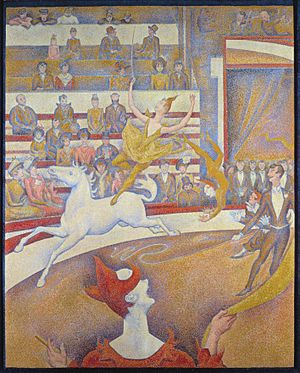
Seurat believed that a painter could use colour to create harmony and emotion in art in the same way that a musician uses counterpoint and variation to create harmony in music. He theorized that the scientific application of colour was like any other natural law, and he was driven to prove this conjecture. He thought that the knowledge of perception and optical laws could be used to create a new language of art and he set out to show this language using lines, colour intensity and colour schema. Seurat called this language Chromoluminarism.
Seurat believed that:
- The emotion of gaiety can be achieved by the domination of luminous hues, warm colours, and by the use of lines directed upward.
- Calm is achieved through an equivalence/balance of the use of the light and the dark, by the balance of warm and cold colours, and by lines that are horizontal.
- Sadness is achieved by using dark and cold colours and by lines pointing downward.
Interesting facts about Georges Seurat
- As an artist, Seurat was both extremely sensible and passionate for logical abstraction and an almost mathematical precision of mind.
- He heard lectures in the 1880s by the mathematician Charles Henry at the Sorbonne, who discussed the emotional properties and symbolic meaning of lines and colour.
- He also studied the works of Eugène Delacroix carefully, making notes on his use of color.
- The works of Seurat became a source of inspiration for the Cubists from 1911.
- On 2 December 2021, Google honored Seurat with a Google Doodle on his 162nd birthday.
Paintings
-
Seurat, 1879–80, Landscape at Saint-Ouen, oil on panel, Metropolitan Museum of Art
-
Seurat, 1879, Flowers in a vase, oil on canvas, Fogg Museum
-
The Laborers 1883, National Gallery of Art Washington, DC.
-
Study for A Sunday Afternoon on the Island of La Grande Jatte, 1884–85, Metropolitan Museum of Art, New York
-
View of Fort Samson 1885, Hermitage Museum, St. Petersburg
-
The Seine and la Grande Jatte – Springtime 1888, Royal Museums of Fine Arts of Belgium
-
The Eiffel Tower 1889, California Palace of the Legion of Honor, San Francisco
Drawings
-
Child in White, 1884–85, Solomon R. Guggenheim Museum
Exhibitions
From 1883 until his death, Seurat exhibited his work at the Salon, the Salon des Indépendants, Les XX in Brussels, the eighth Impressionist exhibition, and other exhibitions in France and abroad.
- Salon, Paris, 1 May–20 June 1883
The Salon showed Seurat's drawing of Edmond Aman-Jean. - Salon des Indépendants, Paris, 15 May–30 June 1884
Seurat showed Une Baignade, Asnières, after the official Salon had rejected it. Seurat's debut as a painter. - Salon des Indépendants, Paris, 10 December 1884 – 17 January 1885
- Works in Oil and Pastel by the Impressionists of Paris, American Art Association, New York, April and May 1886.
Organised by Paul Durand-Ruel. - Impressionist exhibition, Paris, 15 May–15 June 1886
Un dimanche après-midi à l'Île de la Grande Jatte shown for the first time. - Salon des Indépendants, Paris, 21 August–21 September 1886
- Les impressionnistes, Palais du Cours Saint-André, Nantes, 10 October 1886 – 15 January 1887
- Galerie Martinet, Paris, December 1886 – January 1887
- Les XX, Brussels, February 1887
- Salon des Indépendants, Paris, 26 March–3 May 1887
- Théâtre Libre, Paris, November 1887 – January 1888
Works by Seurat, Signac and van Gogh. - Exposition de Janvier, La Revue indépendante, Paris, January 1888
- Exposition de Février, La Revue indépendante, Paris, February 1888
- Hôtel Drouot, Paris, 1–3 March 1888 (sales exhibition)
- Salon des Indépendants, Paris, 22 March–3 May 1888
- Tweede Jaarlijksche Tentoonstelling der Nederlandsche Etsclub, Arti et Amicitiae, Amsterdam, June 1888
Drawing Au café concert, lent by Theo van Gogh. - Les XX, Brussels, February 1889
- Salon des Indépendants, Paris, 3 September–4 October 1889
- Salon des Indépendants, Paris, 20 March–27 April 1890
Showed Le Chahut, Jeune femme se poudrant and 9 other works. - Les XX, Brussels, 7 February–8 March 1891
Showed Le Chahut and 6 other paintings. - Salon des Indépendants, Paris, 20 March–27 April 1891
Showed Le Cirque and four paintings from Gravelines.
Posthumous exhibitions:
- Solomon R. Guggenheim Collection of Non-Objective Paintings, South Carolina, 1938, Gibbes Memorial Art Gallery
See also
 In Spanish: Georges Pierre Seurat para niños
In Spanish: Georges Pierre Seurat para niños


